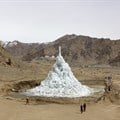More of a giant France-sized glacier in Antarctica is floating on the ocean than previously thought, scientists said on Tuesday, 20 March, raising fears it could melt faster as the climate warms and have a dramatic impact on rising sea-levels.
The Totten Glacier is one of the fastest-flowing and largest glaciers in Antarctica with scientists keen to keep a close eye on how it melts given the enormous amount of water it could potentially unleash.
Using artificially created seismic waves that help scientists see through the ice, researchers have discovered that more of the Totten Glacier floats on the ocean than initially thought.
"In some locations we thought were grounded, we detected the ocean below indicating that the glacier is in fact floating," said Paul Winberry from Central Washington University, who spent the summer in Antarctica studying the Totten.
The findings are important because recent studies have shown the Totten Glacier's underbelly is already being eroded by warm, salty sea water flowing hundreds of kilometres inland after passing through underwater "gateways".
As it does, the portion of the glacier resting on water rather than rock increases, accelerating the pace of disintegration.
Winberry said more of the glacier floating on a warming ocean could help explain recent periods of accelerated melting.
"It also means the Totten might be more sensitive to climate variations in the future," he added.
Glaciers are huge bodies of dense ice that slowly move down valleys, mountains and slopes under their own weight over many centuries, sculpting the earth below as they go.
They hold the vast majority of Earth's fresh water and are the main contributor to rising sea levels when they melt.
According to NASA monitoring, between 2002 and 2016, Antarctica lost 125 gigatonnes of ice per year, causing sea levels worldwide to rise by 0.35 millimetres annually.
From the air, the contours of Totten Glacier are invisible because the entire Antarctic continent is covered by a seamless, kilometres-thick blanket of snow and ice.
That is why scientists are so determined to understand what is happening underneath the glacier, hidden from view.
Lindsay Samson 30 Nov 2016 Team leader Ben Galton-Fenzi, from the Australian Antarctic Division, said the Totten Glacier contains enough ice to raise global sea levels by about three metres if it all melted.
"Since the 1900s the global sea-level has risen by around 20 centimetres and by the end of the century it's projected to rise by up to one metre or more, but this is subject to high uncertainty which is why studying glaciers such as the Totten is important," he said.
"These precise measurements of Totten Glacier are vital to monitoring changes and understanding them in the context of natural variations, and the research is an important step in assessing the potential impact on sea-level under various future scenarios."
Instruments to measure the glacial flow, speed and thickness have been left on the glacier for another 12 months collecting data.
Source: AFP
























